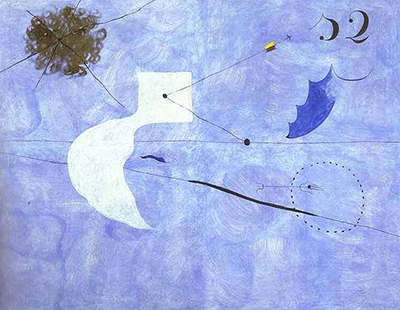There are several items of interest to be found in Siesta, an abstract painting by Joan Miro from 1925.
Here we find a single shape of white along with a number of thin, black lines. There are a number of dots which together form a circle on the right hand side of the composition and there is also lettering in the top right which is particularly unusual for this artist, but was seen more commonly within 20th century art, such as Rene Magritte's The Treachery of Images, for example. So, several questions here after our initial glance of the piece. The background is a relatively light blue, certainly lighter than most backgrounds used by Miro but it does continue in the single colour style which was intended to allow the main content to take centrestage, and for their colours to be shown off as well as possible. This style from Miro is part of his automatic approach to art, where very little conscious planning was involved, with the bias being towards spontaneous work.
We managed to uncover two drawings which were used by the artist to prepare for this final artwork. They help us to understand a little more about his thought processes for this painting, as well as explaining a little more about just what we are looking at. We have here a collection of objects which are placed in front of a wide expanse of space, where perspective and sizing is far from reality. Miro started this process with figures, wine, food and a beautiful landscape before slowly becoming more abstract as he moved through his study iterations. Without the earlier drawings, it would be nearly impossible to understand the items in the final piece. It sums up his own work with abstraction, where he slowly developed more and more extreme techniques across that period.




